You’ve probably seen a lot of marketing claims on the labels of food and skincare products. Words like “natural,” “wild-crafted,” and “eco-friendly” are everywhere because they appeal to modern consumers.
However, there’s only one label you can really trust: USDA Certified Organic.
All of the other words are mostly meaningless because there aren’t many regulations that require growers and manufacturers to back up their claims. Slapping the word “natural” on a label doesn’t mean the product was made without pesticides or even that it contains 100% natural ingredients.
On the other hand, USDA Organic is a very strictly regulated label. Only products that meet extremely exacting standards get the official organic seal— and that includes certain skincare products.
To make things clearer, here’s a look at what USDA Certified Organic really means and why you want to start looking for it in skincare as well as food.
What Is USDA Organic?
The Basics of Being Organic
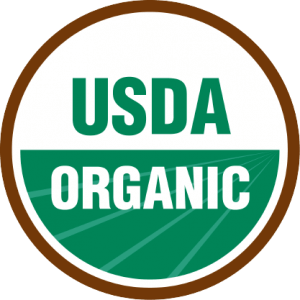
Getting an organic certification means that a food or ingredient is the essence of natural (the word you see thrown around so often).
Because of the way conventional farming works, it’s almost easier to describe organic by what it’s not.
As many people are familiar with by now, one of the central standards for organic produce is that no synthetic pesticides, herbicides, or fertilizers can be used. That means none of the toxic chemicals frequently used in conventional farming get sprayed on organic farms.
Instead, there is a list of organic-approved pest and weed controls that are based on natural rather than synthetic ingredients. Most farmers use these only as needed and rely more on tactics like crop rotation, interplanting, and mechanical weeding.
Another very important facet of USDA Certified Organic is that GMOs are banned.
GMOs is short for genetically modified organisms. These are hugely controversial “new age” crops that have been manipulated genetically, mainly by inserting a gene from an unrelated species (like a bacteria) into a plant. Their long-term health effects are completely unknown, and they frequently cross-contaminate non-GMO plants.
If you want to avoid them, organic is the way to go.
Requirements for Farm Animals
If an organic farm has livestock as well as crops, some additional standards will apply.
For organic certification, animals must have outdoor access. Animals that naturally graze also must get a minimum amount of their diet from pasture. Cows, for example, have to get at least 30% of their diet from pasture during the grazing season.
All food given to animals must be organic and GMO-free. This means that no herbicides or chemical fertilizers can be used on the pastures or on their feed.
Organic standards also mean no antibiotics and no synthetic hormones. Many farmers use preventative measures and natural treatments to accomplish this— and have very healthy animals. (Note: Antibiotics are used if no other treatment works, but the animal must be taken to a non-organic herd or farm.)
The USDA Organic Certification Process
How Certification Works
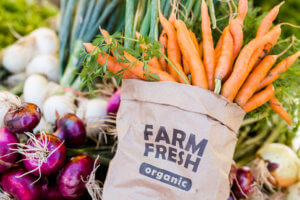
As you can see, there are a number of regulations farmers have to follow to be organic. But even more importantly, in order to get certified, every step of the process has to be documented and verified.
This is why USDA Organic actually means something (unlike the loose terms “natural,” “eco-friendly,” etc.). The entire process is government-regulated and uses third parties to certify farmers and other businesses.
And getting certified is not an easy process.
At minimum, certification takes 3-6 months, and that’s only if there’s clear documentation of organic practices dating back several years. For many farms, it takes at least a few years to transition to USDA Organic and get official certification.
This is because no prohibited substances (synthetic pesticides, fertilizers, etc.) can be used or applied for three years prior to certification. Chemical residue is real, and this part of the certification process ensures that no contamination will happen from past non-organic growing methods.
Once this is achieved, farmers/businesses must submit complete documentation of their growing practices, general operations, every organic product, and a detailed plan of how they will maintain organic practices as well as a history of any substances used on the land for the past three years.
This information is given to a USDA-accredited certifying agent as part of an application for organic certification.
The certifying agent then reviews the information and makes a thorough on-site inspection. If everything checks out, an organic certificate is (finally) given. A detailed update and on-site inspection are then required yearly to maintain certification.
All in all, it’s a very labor-intensive process with very high standards!
Certification Covers Farm to Factory to Shelf
We often think of organic mainly in relation to whole foods grown on a farm. However, the USDA Organic certification covers every step of the process for more complex food products as well.
Unless a food is taken straight from the farm to a consumer, it has to go through some type of packaging and/or manufacturing process, and this means more regulations. Many organic products have multiple ingredients, which means the source of each ingredient has to be documented as well.
At the farm level, the USDA inspection process goes through everything related to the growing end of things. This includes where the seeds come from, how seedlings are taken care of, planting and irrigation, pest management, soil health, strategies to prevent contamination, and so on.
On the manufacturing end of things, the source of each ingredient has to be documented and verified as either organic or on a list of what are called “approved non-agricultural ingredients”— baking soda, pectin, etc.
Artificial preservatives, flavorings, and colorings are prohibited from organic products. There are also various regulations regarding cleanliness in factories, chemicals that cannot be used on produce post-harvest (many are used on conventional products to increase shelf life), and more.
As you can see, every part of the farm to table process is covered. This also includes the “farm to shelf” process where skincare is concerned.
Understanding USDA Organic Labels
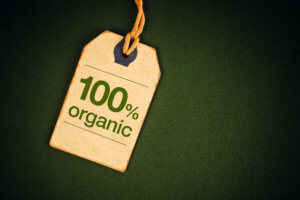
Now that you know more about the certification process, it’s also important to understand what the official USDA Certified Organic seal on a product really means.
There are two main categories of products that are permitted to use the seal.
The first is “100% Organic” products. As you can tell by the name, this category includes only products that contain 100% organic ingredients. Most often, products in this category are whole produce (carrots, apples, etc.), animal products (eggs, meat, etc.), or lightly processed foods.
Any products that qualify can use the USDA Certified Organic seal on their labels and can also advertise as being 100% organic.
The second category is considered simply “Organic.” Products must have a minimum of 95% organic ingredients, and the remaining 5% must come from a strict “safe to use” list. Synthetic additives and GMOs are still prohibited as are certain methods like ionizing radiation.
Any qualifying products can have the USDA Certified Organic seal and are considered organic.
It’s important to note that “organic” is not necessarily inferior to “100% organic.” The 5% is an allowance for ingredients that are not available in organic form or that are approved non-agricultural ingredients, like baking soda or citric acid.
Basically, as much of the product as possible is organic, and the remaining few ingredients are carefully chosen.
There’s also another category known as “Made With Organic Ingredients,” but these products only have to have a minimum of 70% organic ingredients and are not allowed to display the USDA seal.
This means that anytime you see the official organic seal, you can be confident that at least 95% of that product is made of organic ingredients and any others are carefully selected from a strict list.
What is USDA Organic Skincare?

It’s very rare to see the certified organic label on skincare products, and there’s a reason for that.
When it comes to cosmetics and skincare, the USDA does not have specific organic regulations. It only oversees food and food products, and most skincare products contain non-food (not to mention highly toxic) ingredients.
This means that in order for a skincare product to be certified as organic, not only does the company that makes it have to go through the rigorous sourcing, documentation, and inspection process, it also has to use at least 95% of food-quality ingredients!
There’s only a short and strict list of non-agricultural ingredients that can make up the remaining 5% of skincare products. These do not include synthetic preservatives or any nasty chemicals you would typically find in skincare.
The bottom line is that an official organic seal means a product has been certified to the same standards as the organic food that you would put in your body.
So if you do see the USDA Certified Organic seal on a skincare product, you’ll know that it is an exceptional product made with clean (and real) ingredients— one you can feel confident using on your skin!
Why Organic Skincare is Important
Now you know what organic skincare means, but is really that important?
The answer is, yes, absolutely— and more important than most people realize. Anything you put onto your skin can get into your body AND many toxins that are commonly found in skincare products can actually accelerate the aging process in your skin.
Toxic Pesticides are a Real Problem
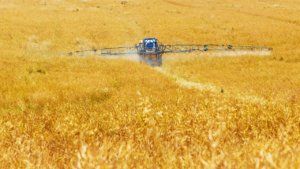
The dangers of pesticides (and chemical fertilizers, etc.) are very real and should not be underestimated.
Glyphosate (the active ingredient in Roundup) has been linked to cancer. Organophosphates may cause neurological damage and are especially toxic for children. Atrazine leaches into drinking water and is linked to hormone disruption. Neonicotinoids are suspected of wiping out bee colonies.
The list goes on, but you get the idea.
And not only are these chemicals toxic (they all come with the skull and crossbones symbol that signifies poison), they don’t simply disappear after being applied.
A 2021 report from the Environmental Working Group (EWG) found that at least 70% of non-organic produce was contaminated with pesticide residue. Some even had multiple chemicals attached to them.
Pesticides are in the (non-organic) food you eat, and you can bet they are in your plant-based skincare products, too.
Toxins Can Be Absorbed Through Your Skin
Another reason USDA organic skincare is important is because toxins are able to be absorbed through your skin into your bloodstream.
Not everything you put on your skin does get absorbed, of course. Much depends on the size of the molecules and other factors like the integrity of your skin’s barrier.
However, many of the chemicals specifically found in pesticides can be absorbed through the skin.
This means that the more of them you are exposed to, the higher your risk of allowing endocrine disruptors, neurotoxins, and even potential carcinogens into your body. They might not be present in highly concentrated amounts, but their effects will add up over time.
Toxins Can Make Your Skin Look Older

You may not know this but many environmental toxins, including certain synthetic chemicals, majorly accelerate skin aging.
They do this mainly by damaging your skin’s natural barrier and by inducing oxidative damage at the cellular level.
Oxidative damage, also known as oxidative stress, is caused by free radicals that attack other molecules, including important skin molecules. When your body can’t keep up with fighting free radicals and repairing the damage, your skin starts to show familiar signs of aging like wrinkles, under-eye bags, and saggy skin.
While there are ways to reverse this damage, it’s much better to prevent it in the first place by using clean skincare products. And organic products are free of all synthetic chemicals, including pesticides and additives.
No Greenwashing
Greenwashing is a term that refers to companies or products that seem like they are natural and environmentally friendly but aren’t.
Many products are plastered with marketing terms like “natural,” “green,” and even “paraben-free,” but if you actually read the label, you’ll discover a host of synthetic or unpronounceable ingredients.
The USDA Certified Organic label is the only one that covers every step of the process from farm to shelf and has strict regulations that are enforced. Any product that carries it is not greenwashed, and you can actually trust what’s on the label.
USDA Organic Skincare for Age-Defying Skin 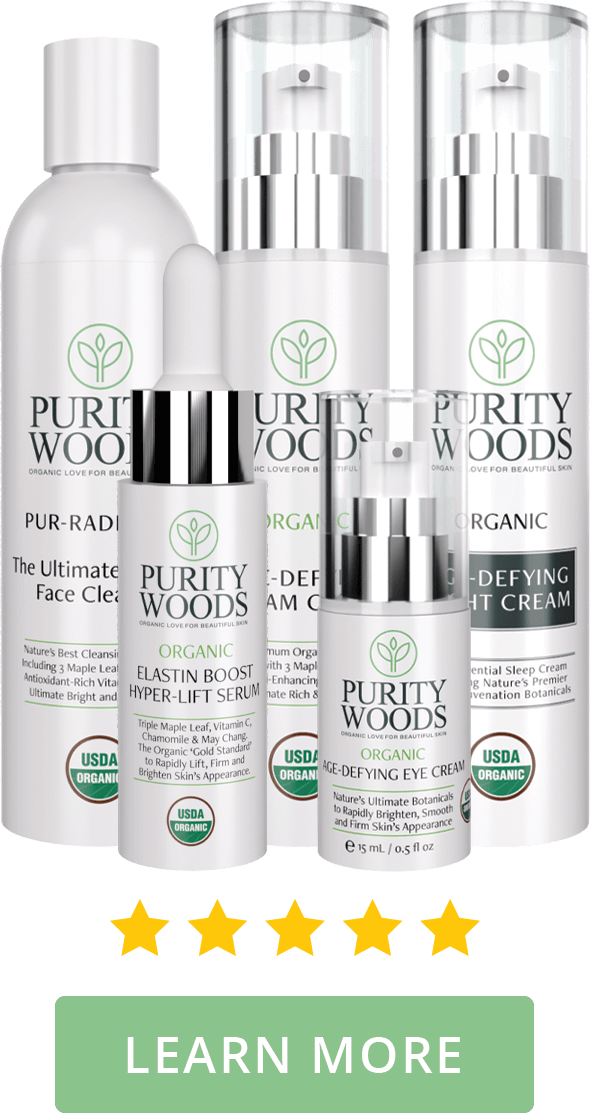
If you are ready to use certified organic products with food-quality ingredients on your skin, look into Purity Wood’s line of USDA Organic skincare products.
Every product is not only formulated to strict organic certification standards, it also includes only the best plant-based extracts and botanicals for quickly erasing signs of aging like wrinkles, dark spots, and saggy-looking skin.
There are NO toxic chemicals, GMOs, or artificial anything (as per organic standards), and all products are cruelty-free and never tested on animals.
You’ll only find premium hydrating ingredients like mango seed butter, superpowered antioxidant ingredients like astaxanthin, and the revolutionary elastin-boosting maple leaf extract. All are proven effective and straight from nature.
Look into Purity Wood’s Age-Defying skincare products for yourself here and start treating your skin to guaranteed natural care.


